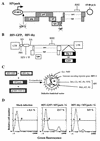Lentivirus vectors using human and simian immunodeficiency virus elements
- PMID: 10074131
- PMCID: PMC104041
- DOI: 10.1128/JVI.73.4.2832-2840.1999
Lentivirus vectors using human and simian immunodeficiency virus elements
Abstract
Lentivirus vectors based on human immunodeficiency virus (HIV) type 1 (HIV-1) constitute a recent development in the field of gene therapy. A key property of HIV-1-derived vectors is their ability to infect nondividing cells. Although high-titer HIV-1-derived vectors have been produced, concerns regarding safety still exist. Safety concerns arise mainly from the possibility of recombination between transfer and packaging vectors, which may give rise to replication-competent viruses with pathogenic potential. We describe a novel lentivirus vector which is based on HIV, simian immunodeficiency virus (SIV), and vesicular stomatitis virus (VSV) and which we refer to as HIV/SIVpack/G. In this system, an HIV-1-derived genome is encapsidated by SIVmac core particles. These core particles are pseudotyped with VSV glycoprotein G. Because the nucleotide homology between HIV-1 and SIVmac is low, the likelihood of recombination between vector elements should be reduced. In addition, the packaging construct (SIVpack) for this lentivirus system was derived from SIVmac1A11, a nonvirulent SIV strain. Thus, the potential for pathogenicity with this vector system is minimal. The transduction ability of HIV/SIVpack/G was demonstrated with immortalized human lymphocytes, human primary macrophages, human bone marrow-derived CD34(+) cells, and primary mouse neurons. To our knowledge, these experiments constitute the first demonstration that the HIV-1-derived genome can be packaged by an SIVmac capsid. We demonstrate that the lentivirus vector described here recapitulates the biological properties of HIV-1-derived vectors, although with increased potential for safety in humans.
Figures




Similar articles
-
Development of an Rev-independent, minimal simian immunodeficiency virus-derived vector system.Hum Gene Ther. 2001 May 1;12(7):847-57. doi: 10.1089/104303401750148847. Hum Gene Ther. 2001. PMID: 11339901
-
A novel lentivirus vector derived from apathogenic simian immunodeficiency virus.Virology. 2001 Dec 20;291(2):191-7. doi: 10.1006/viro.2001.1183. Virology. 2001. PMID: 11878888
-
Heterologous human immunodeficiency virus type 1 lentiviral vectors packaging a simian immunodeficiency virus-derived genome display a specific postentry transduction defect in dendritic cells.J Virol. 2003 Sep;77(17):9295-304. doi: 10.1128/jvi.77.17.9295-9304.2003. J Virol. 2003. PMID: 12915545 Free PMC article.
-
Development of HIV vectors for anti-HIV gene therapy.Proc Natl Acad Sci U S A. 1996 Oct 15;93(21):11395-9. doi: 10.1073/pnas.93.21.11395. Proc Natl Acad Sci U S A. 1996. PMID: 8876146 Free PMC article. Review.
-
Lentiviral vectors for gene therapy of HIV-1 infection.Curr Gene Ther. 2002 Feb;2(1):23-43. doi: 10.2174/1566523023348165. Curr Gene Ther. 2002. PMID: 12108972 Review.
Cited by
-
The U3 and Env Proteins of Jaagsiekte Sheep Retrovirus and Enzootic Nasal Tumor Virus Both Contribute to Tissue Tropism.Viruses. 2019 Nov 14;11(11):1061. doi: 10.3390/v11111061. Viruses. 2019. PMID: 31739606 Free PMC article.
-
Cross-packaging of genetically distinct mouse and primate retroviral RNAs.Retrovirology. 2009 Jul 14;6:66. doi: 10.1186/1742-4690-6-66. Retrovirology. 2009. PMID: 19602292 Free PMC article.
-
Substitution of the Rev-response element in an HIV-1-based gene delivery system with that of SIVmac239 allows efficient delivery of Rev M10 into T-lymphocytes.AIDS Res Ther. 2008 Jun 5;5:11. doi: 10.1186/1742-6405-5-11. AIDS Res Ther. 2008. PMID: 18534033 Free PMC article.
-
Gene Therapy Applications of Non-Human Lentiviral Vectors.Viruses. 2020 Sep 29;12(10):1106. doi: 10.3390/v12101106. Viruses. 2020. PMID: 33003635 Free PMC article. Review.
-
Identification of unique reciprocal and non reciprocal cross packaging relationships between HIV-1, HIV-2 and SIV reveals an efficient SIV/HIV-2 lentiviral vector system with highly favourable features for in vivo testing and clinical usage.Retrovirology. 2005 Sep 16;2:55. doi: 10.1186/1742-4690-2-55. Retrovirology. 2005. PMID: 16168051 Free PMC article.
References
-
- Banapour B, Marthas M L, Munn R J, Luciw P A. In vitro macrophage tropism of pathogenic and nonpathogenic molecular clones of simian immunodeficiency virus (SIVmac) Virology. 1991;183:12–19. - PubMed
-
- Berchtold S, Hornung U, Aepinus C. The activation domain of simian immunodeficiency virus SIVmac239 Rev protein is structurally and functionally analogous to the HIV-1 Rev activation domain. Virology. 1995;211:285–289. - PubMed
-
- Brewer G J, Torricelli J R, Evege E K, Price P J. Optimized survival of hippocampal neurons in B27-supplemented Neurobasal, a new serum-free medium combination. J Neurosci Res. 1993;35:567–576. - PubMed
Publication types
MeSH terms
Grants and funding
LinkOut - more resources
Full Text Sources
Other Literature Sources
Medical

